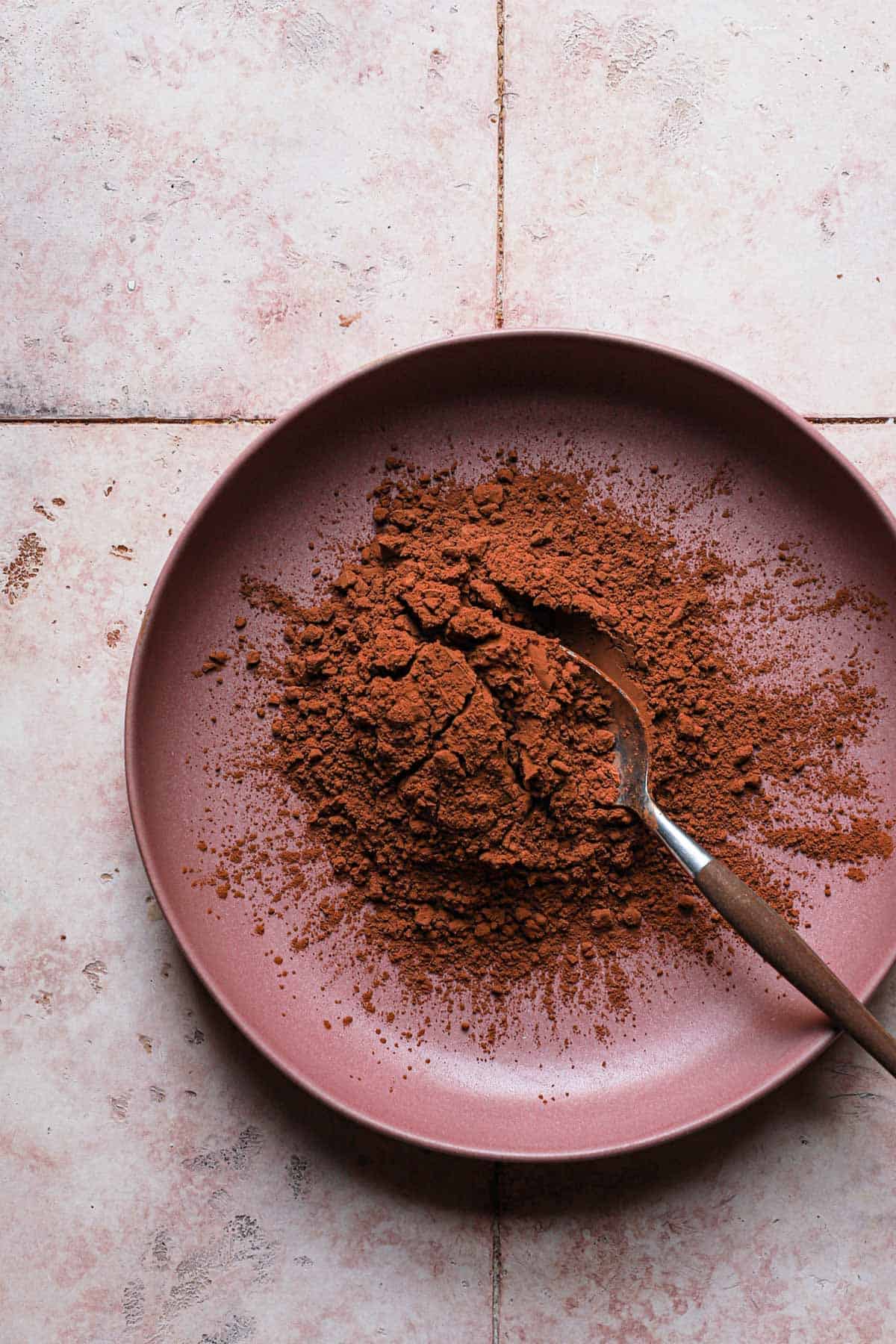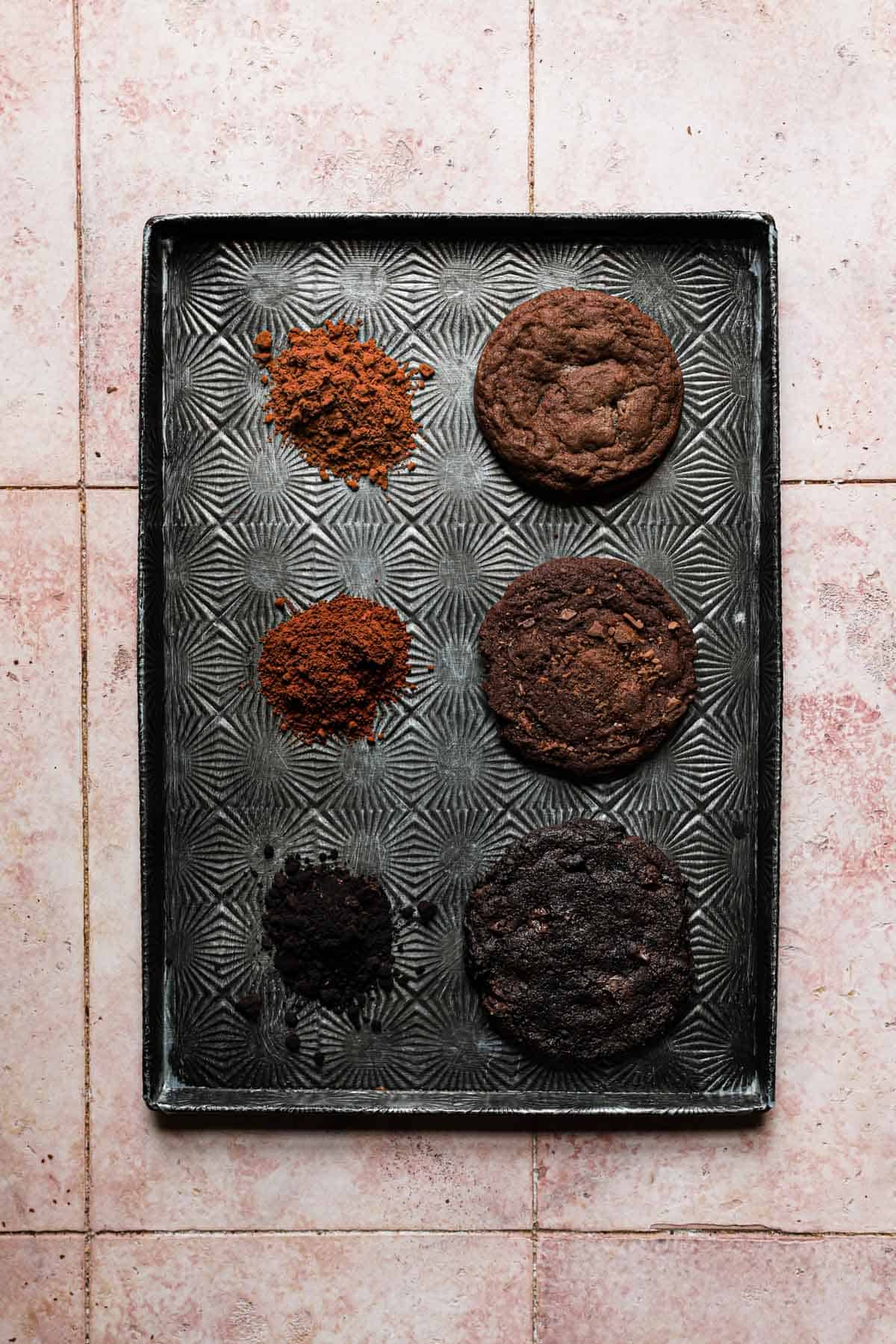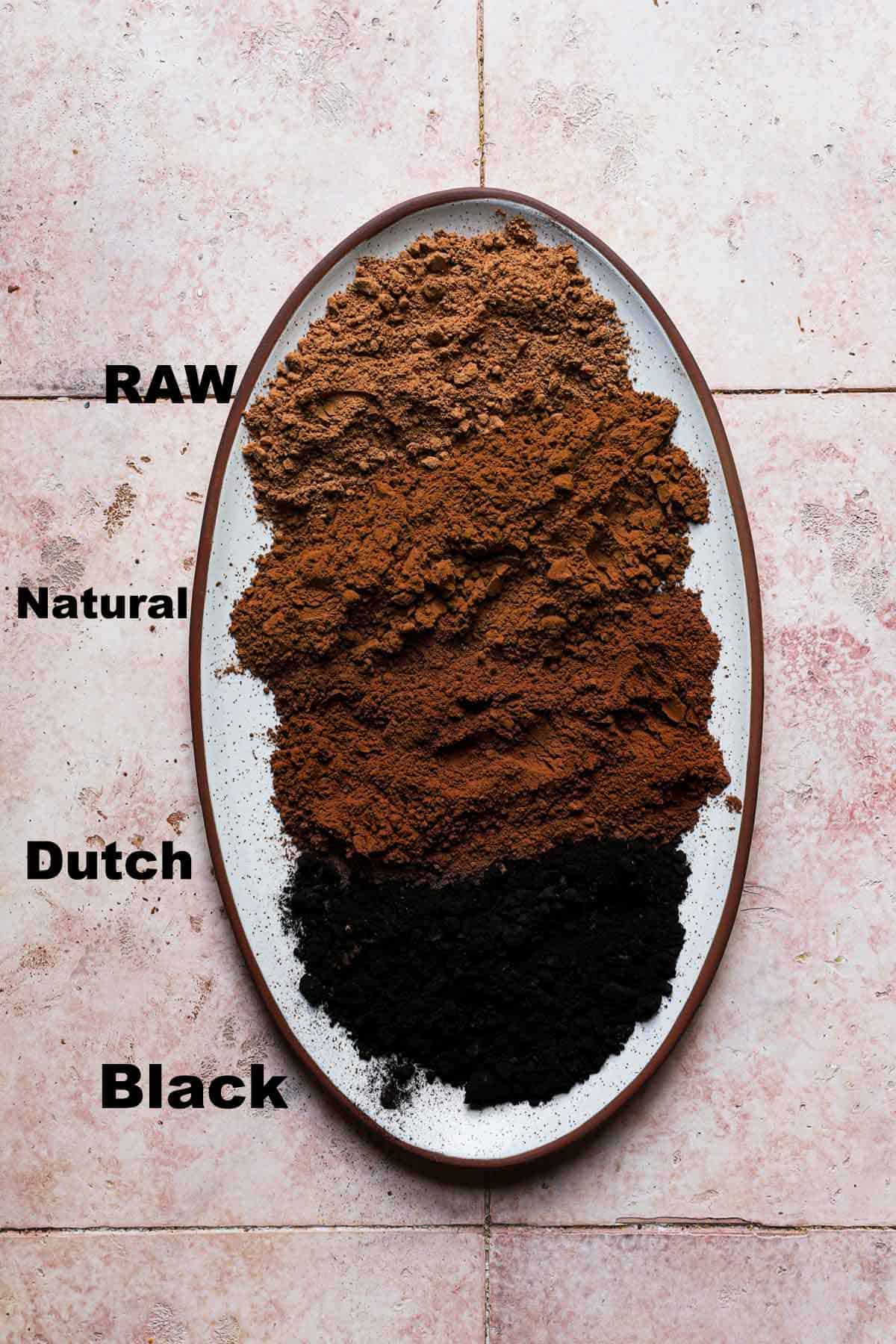Last updated on June 13th, 2025.
Do you know What Is Cocoa Powder? It seems like a very rhetorical question, but the answer might not be as simple and might even surprise you.
In this post, I will not only answer what it is and how it is made but also how you can and should use it in baking to sharpen your baking skill.

This post is another addition to my Chocolate series, be sure to read my other articles all about the science and use of chocolate in baking:
What Is Cocoa Powder?
Sometimes knows as chocolate powder, it is an unsweetened fine powder we get when we remove 78-90% of the fat from unsweetened chocolate. Here are a few more interesting facts:
- The powder in its natural state has a deep rich chocolate flavor, a red-brown color, and a PH level of 5-6.
- It is 22% starch and sugar.
- By law, it must contain 10-12% fat in the USA or 20-22% in Europe.
- To be labeled as pure cocoa, no other ingredients should be added.
- It is not the same as hot cocoa powder. Hot cocoa powder is a mixture of cocoa powder, dry milk powder and sugar.
Note: Cacao is different than cocoa powder. Cacao did not go through the process of roasting that cocoa did.
How is Cocoa Powder Made?
You might be surprised to know that the powder, also called coco powder, cocao powder, and sometimes even cocoa power (lol, I can’t argue with it) is in fact not a chocolate product. It is, in fact a cocoa beans product.
What is the difference?
Chocolate products are made using chocolate liquor, also known as unsweetened chocolate (see below, step 5), by adding sugar or other ingredients such as milk solids and emulsifiers. Cocoa beans products are any products to which no sugar is added to it, such as cocoa nibs and cocoa butter.
Let’s take a quick look at the process of how it is made and its products:
- Harvesting the Cacao Beans.
- Cacao Fermentation – the beans are buried underground to ferment.
- Roasting – the fermented beans are roasted and the shell is separated from the meat (the cocoa nibs).
- Grinding cocoa nibs – at this point, the fermented and roasted beans are now referred to as cocoa nibs and they are pressed through a series of rollers.
- Chocolate Liquor – the cocoa nibs are pressed into a very smooth paste, in its warm stage is liquid (chocolate liquor). As it hardens it is known as Unsweetened Chocolate. All products that are made by adding sugar to the liquor are called Chocolate Products.
- Squeezing the liquor under high pressure. As a result, the butter melts and separates it from the cocoa solids, creating two different cocoa products: natural powder and cocoa butter.
Baking With Cocoa Powder
Many chocolate recipes like Brownie Cake, Orange Chocolate Cake, Double Chocolate Muffins, and Biscoff Brownie call for this magical powder. In its raw form, it is a dry ingredient. It is also starch and an acidic substance. Here are some of the points to guide you when baking with any type:
- It is starch that will absorb liquid. Not only that, the starches’ molecular structure allows the molecules to swell and rearrange themselves into a strong stabilized structure. That means that too much of it also means a dry-baked good. So to avoid your baked goods from coming out dry, either reduce the amount of flour (by the same amount of cocoa) or increase the amount of liquid in your formula, about 1/4-1/3 cup of liquids per 1/2 cup of powder.
- It is bitter and unsweetened. There is no sugar added to it, and you might want to increase the amount of sugar in your recipe. (Since sugar attracts humid, you might not need to increase the amount of the liquid)
- It does not dissolve in water or any other liquid. The hot cocoa mix we use to make hot chocolate has emulsifiers in it, preventing the powder from sinking to the bottom. That is not the case with cocoa powder, however, it will release its flavors when mixed with hot water (blooming), and it is a common technique in baking. You can read more about it in my book “Baking Science”.
- To convert a recipe into a chocolate recipe, I like to replace 15% of the amount of flour with any type of powder.
- It is a pure product that mainly contains cocoa solids, unlike melted chocolate which also includes a large amount of fat, and sometimes sugar and emulsifiers. This is why using it is the best way to enhance the chocolate flavor when baking.
- Pay attention to the PH level of the type you are using. I listed below the different types including their PH level and what you can expect when baking. The lower the PH level the more acidic the powder is. An acid substance will accelerate the setting process of our baked goods which means our baked goods will need less time to bake and will most likely spread less. Less time in the oven also means less loss of moisture and a lower risk of our baked goods drying out.
Let’s take a look at the below image
I baked my favorite Triple Chocolate Drop Cookies three times. Each time I used a different type, and the result was different for each batch.
- Natural (top). The cookies had the lightest color, and since the powder is acidic it activated the baking soda and as a result, they puffed the most. The presence of acid also speed up the baking time and the cookies were done in 8 minutes. The cookies have a subtle chocolate flavor.
- Dutch (middle). The cookies are darker ib color not only because of the darker shade of the powder but also because the cookies needed an extra 2 minutes in the oven. The lack of acid allowed the cookies to spread more. The cookies have an enhanced and rich chocolate flavor.
- Black (bottom). The biggest difference was the baking time which went from 8 minutes to 12 minutes, as a result, this batch was the least moisture and was a bit dry. As you can see the cookies are completely dark and spread the most out of the three batches.

Different Types
Since comes in a few different varieties, each has different properties that should be taken into consideration when baking.

Natural
How it is made
This is the most common type and is easily found at most local markets. It is made by pressing melted unsweetened chocolate (chocolate liquor) and separating the fat (cocoa butter) and cocoa solids (powder).
PH Level
It has a PH level of 5-6, meaning it is acidic and will activate the baking soda, and together they will act as a leavening agent.
What does cocoa powder look like (natural) and taste?
It is a very fine red-brown powder. It is unsweetened with a strong chocolate flavor, slightly bitter.
Baking with Natural Cocoa
It is an acidic substance. It will create a chemical reaction when mixed with baking soda (potassium carbonate). To activate use 1/4 tsp of baking soda for every 1/3 cup of cocoa powder. Acid also accelerates the setting time, giving us higher-leavened baked goods and preventing them from spreading.
Where To Buy?
At your local grocery store, at the baking aisle.
Dutch Process
How it is made
It is a natural powder that has been washed with an alkaline solution. As a result, the PH level is now 7, it is natural.
Appearance and Taste
Like the natural cocoa, dutch cocoa is red-brown but has a darker tone, it also has a smoother and richer flavor.
Baking with Dutch powder
Since it is a natural substance it will not activate the baking soda, so use baking powder as a leavener. Expect your baked goods to take more time to bake and spread more. Check out these Biscoff Brownies and see how I used this type of powder.
Where To Buy?
These days it is as common as a natural one. Check the ingredients label, if it says alkaline then it’s dutch.
Black Cocoa Powder
How it is made?
Black cocoa powder is natural cocoa powder that has been washed with an alkali solution more than once.
PH Level
Between 7-8, depending on the brand. It is an alkaline substance.
Appearance and Taste
It is black and has a milder and smoother chocolate flavor.
Baking With Black Powder
Much like Dutch cocoa power it will not react with the baking soda and will not speed the setting process of your baked goods. Its dark color will give us a darker more “dramatic” dark color, much like Oreo cookies.
The process of making black cocoa strips the powder of its acid and also most of its fat. Less fat molecules mean more space for starch molecules and we must keep it in mind when we bake with this type of powder.
As a rule, I like to use black cocoa for its appealing appearance, by replacing up to 1/4 (2 BTS if the recipe calls for less than 1/2 cup) of the powder the recipe calls for with black cocoa.
Where To Buy?
Specialty food stores or online.
Raw Cacao Powder
How it is made?
The same as a natural type but the cacao beans have not been roasted. Also, there is no discard of solids during the process.
PH Level
5.5, it is an acidic substance and will react with baking soda much like Natural.
Appearance And Taste
It is a very light brown fine powder and has a less distinguished chocolate flavor. It is also more bitter than any other type.
Baking With Raw Cacao Powder
The roasting process of the cacao beans contributes to the development of deep chocolate flavor. Since we skip this part, we also are missing the flavor, and this is the biggest difference when baking.
Where To Buy?
Most well food markets sell it, and online.
What Is The Best Cocoa Powder For Baking?
There is no such thing. Read this article carefully to learn the different properties of each powder, and decide which is best for your recipe. You can use it to bake this Brownie Cake, these Chocolate Drop Cookies, or even this Orange Chocolate Cake. You can also use it to make ice cream or flourless chocolate cake.
Storing
In a cool dry place in your pantry and not over room temperature. If possible place it in an airtight container.
I hope you’ve enjoyed this article and found the information useful. By now I have no doubt that not only do you know What Is Cocoa Powder, but you can also use this new knowledge and elevate your baking.
Here are some more chocolate recipes I know you will love
Matcha Brownies, Chocolate Covered Pecans, Chocolate Covered Graham Crackers, S’mores Pies, Brownie Pizza.
DID YOU FIND THIS USEFUL?
If you tried this recipe or any other recipe by One sarcastic Baker baking blog, please take a movement to rate and comment at the end of each recipe. Your questions, ideas, and thoughts are priceless, and here at OSB we value them more than butter!
And don’t forget to tag me on Instagram


I am taking the EDX course from Harvard on Science and Cooking. Your comments on the pH levels now make more sense to me as I’m learning about molecules and Molarity. I do find that most packages are not explicit enough about the type of product they are selling. Before, I thought that any baked item needed Dutch-processed cocoa powder. But now I see it’s about the pH level and how that impacts the baking process and the final product. Thanks.
Hi Bruce,
Harvard EDX Science and Cooking Class is a fantastic class and I am so excited for you! What I love the most about the class is that it doesn’t just give us the facts but it also gives us the tools to investigate and explore our recipes/ingredients using the science principles.
You are right, brands do not reveal much information mostly because most customers do not really care, this is why I love King Arthur Flour’s products so much, they reveal it all and explain what is in the specific ingredient that is so important to our baking.
Enjoy your journey, it’s the most amazing I’ve taken and still am!